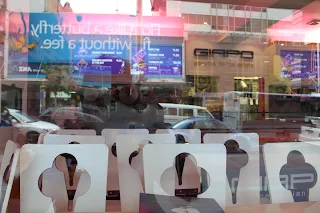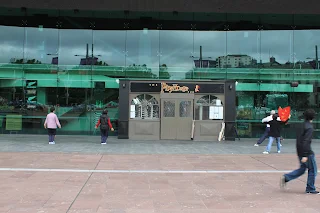
Albee's Kitchen is located in the midst of the hustle and bustle of the main strip in Campsie, sited south-west of Sydney CBD. (282 Beamish Street, on the same side as the shopping centre with K Mart). This suburb has emerged as a very good example of multi-culturalism, a product of over thirty years of open minded Australian government policy and implementation in freeing up immigration from sources hitherto unthought of before 1980. The operators of Albee's Kitchen come from Sarawak, a state on the Borneo side of Malaysia, but they provide a variety of beloved street foods from Peninsular Malaysia, unique dishes of south-east Asia and reflecting the three main ethnic groups that still reside in Malaysia today. Above image - the most delightful curry puffs, with a half portion of hard boiled egg in each, together with a most appetising curry mixture.
The day of my most recent visit to Albee's had their tables fully occupied, with access to behind the kitchen seating areas for those unable to find a table at the front. Small in size, the cafe-restaurant offers a menu with variety. There are impressive photos on the walls to initiate newcomers to Malaysian food, but the fellow lunchers that Saturday seem to know their fare. My attention was caught by a most savoury tasty hotpot ordered at a neighbouring table - egg noodles al dente and more in a rich stock, aromatic of Cantonese traditions and topped by a poached egg. I saw the luscious and tempting photo of char koay teow, a must for any visitor to Penang island. There are stir-frys, curry dishes (notable is the curry fish head) and oodles of noodle choices. Service was friendly and efficient in an atmosphere of a family run business - the customer could readily feel at home as well.
I tested their version of Hainan chicken rice (picture above) - I appreciated their serving of a wholesome soup (upper left) and the extra pickled vegetables beside the vinegar flavoured chili condiment.
Beamish Street also offers fare from Korea, the Philippines, India, the Middle East, Pakistan, Thailand and China. This includes dry goods, spices, groceries and household items. I dropped by an outlet offering practically priced kitchen utensils and equipment. I also got samplings of barbecued roast pork and soy sauced chicken done ala Hong Kong (southern Cantonese). Vehicle parking is best secured along the side streets of Beamish.




































